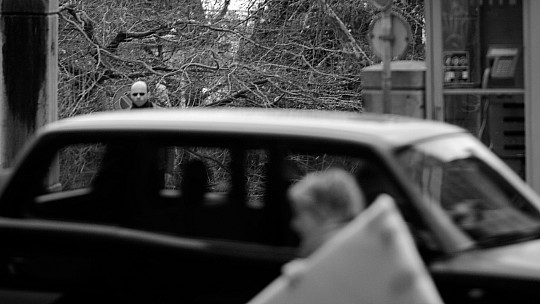As you can clearly see…
MacGuffin
2006
(published in Photosnouvelles)
You are late, something far less credible than true has happened to you: you were an eyewitness to a UFO, and you felt compelled, obliged even, to photograph it. Unfortunately, the resulting photograph is less than remarkable – in fact you could say that, as photos of UFO's go, it's an utter failure. This is not that photograph.
When you finally take your seat, and try to forget the amazing appearance of a extraterrestrial ship just a few moments ago, and try to begin to focus on the plot of this film; you realize you do not know how much time has elapsed since the beginning. Having missed, or suspected to have missed the elements which would allow you to understand what is happening as the film unfolds before you eyes, every detail suddenly appears to have equal potential to be an essential key to understanding. Your task of observing becomes one of investigation.
Just now, two travelers are on a train. One says to the other “What's that extraordinarily complex looking package up there in the baggage rack?”, and the other answers “Oh, that's a McGuffin”. The first one asks “What's a ‘McGuffin?’”. “Well”, the other man says, “It's an apparatus for trapping lions in the Scottish Highlands”. The first man says “But there are no lions in the Scottish Highlands…”, and the other one answers “Well, then that's no McGuffin!”.
That diversionary conversation having run its course, the owner of the object which is not a MacGuffin proceeds to open a dossier such as way as to carefully hide its contents from his fellow passenger. Then, a close-up permits you to clearly see the object which serves as a pretext for establishing the plot: a black-and-white photograph, which you do not know is in actually color since this is a black-and-white film.
The vegetation, architectural elements, climatic conditions, diverse angles and characteristic shadows do not seem to contain the necessary clues for your understanding.
The presence of dark sunglasses worn by the man in the background, on the other hand, seems to be a mechanism employed by the author to signify the presence of an observer: which could be the person himself (the black sunglasses, absorbing all light, could even signify omniscience), or the implicit observer: the author of the photograph.
The status of the photograph itself remains undetermined: is it a functional element of observation, or is it itself the subject of an investigation? It could also be that the content of the image is completely insignificant, that its simple existence – or the circumstances of its creation – are the true plot device.
